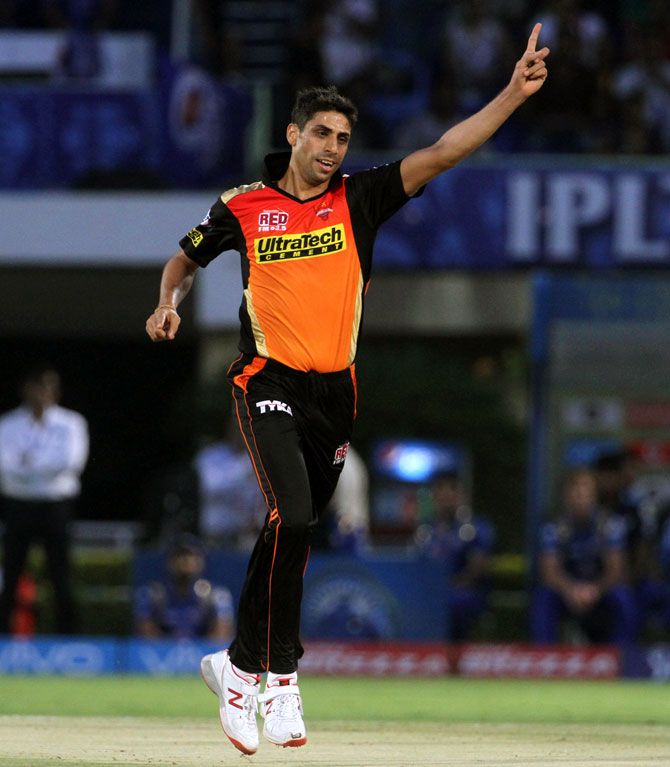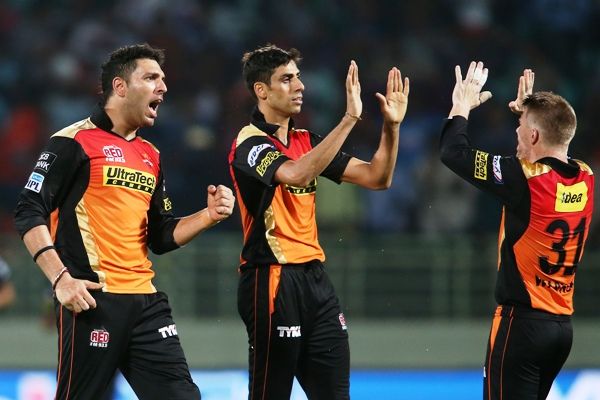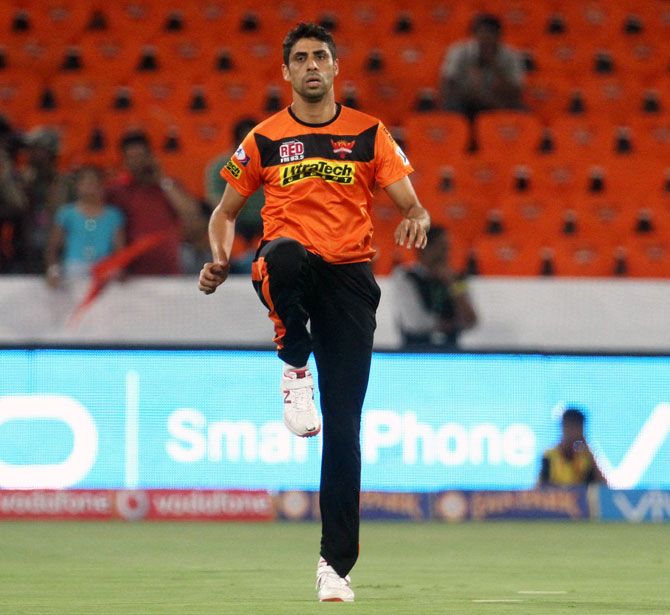'My simple thinking about bowling in the death: Number one is that mentally you have to be very strong,' Ashish Nehra tells Rediff.com's Harish Kotian.

Ever since receiving a second lease of life and a renewed career courtesy of the Indian Premier League, there has been no looking back for Ashish Nehra.
The 37 year old enjoyed a successful season with the Chennai Super Kings in 2015 taking 22 wickets in 16 games before he was bought by the Sunrisers Hyderabad the following season. He repaid their faith by playing a major role in the Sunrisers' IPL triumph last season.
His good showing in the IPL for CSK two years ago saw him make it back to the Indian team in the T20 format where he has become a permanent fixture, featuring in the Australian tour, the Asia Cup and World T20 last year.
Another impressive IPL season and he could find himself packing his bags for the ICC Champions Trophy in England in June.
Nehra hasn't featured in an Indian ODI team in six years; his last appearance was in the semi-final of the 2015 World Cup against Pakistan in Mohali. He believes he can handle the rigours of the 50 overs game.
Asked if India will be looking to add a left-arm fast bowler to the attack for the seamer-friendly conditions in England, Nehra says: "It is not necessary they will be looking for a left-arm seamer. And it is not that I am on trial."
"Everybody knows what I can do if I am fit. If the team management, the captain and coach want me, and if I am ready and raring to go, and if I am fit, then definitely I will play," he adds.
"But it is not that the team is looking for a left-arm fast bowler. "So many teams in the past have played with three left-arm fast bowlers or three right-arm fast bowlers," he explains. "But if you have a left-arm fast bowler it does make a difference."
"Every team likes variety. We have Bhuvneshwar Kumar who can swing the ball or Jasprit Bumrah who is really good with the old ball," Nehra adds.

What has made Nehra a standout performer in the T20 format has been his ability to deliver both, at the start and in the death overs.
He recently became the first left-arm bowler and the eighth overall to take 100 wickets in the IPL, reaching the landmark in 83 games.
"My simple thinking about bowling in the death: Number one is that mentally you have to be very strong," he says.
"Everbody's mindset is different. Yorker is one word which I hear in T20 cricket, the more and more I play. It is very easy to say like everyone says 'Oh, bowl a yorker!' because somebody who never bowled, he doesn't know what it takes to bowl a yorker, especially in Mumbai when the ground is wet."
"It is very easy to say 'Go and bowl a yorker.' If it's in my hands to bowl good yorkers I can bowl six. It is not that easy," he points out.
"There are so many times I have seen that the first ball you bowl goes for a six, the second ball also goes for a six and you feel maybe this over is going for 25, 26 runs. But if you are mentally strong and even if the first two balls go for sixes you can still bowl a 15 run over."
"Those 5, 10 runs make a big difference. In the death overs, only if you execute your skills, you will do well, but you have to be mentally very strong," he adds.
For the veteran pacer, who made his international debut way back in 1999, "recovery is as important as the training."

"If I say it doesn't make a difference, at my age I will be lying. At the age of 38 (he is 37), not only fast bowlers but even for a batsman it becomes difficult."
"You have to put in extra yards even for recovery or training or practice," he explains, "and that is what I have been doing. I have my routine which I follow and it is helping."
Having started with the Mumbai Indians in the inaugural IPL in 2008, Nehra has seen the game undergo a vast change.
"Definitely, from 2008 till now, not only the IPL but cricket worldwide has changed," he says.
"As a bowler you have to evolve, there are so many people who say that batsman are playing new shots, boundaries have become smaller and good wickets and all. That all the bowlers know. As a bowler you can't only look at these negative points, you have to be positive."
"You see so many bowlers bowling yorkers outside the off-stump or a slower bouncer, the bowlers are also looking for the tricks. It is not the case that every time the batsman is winning, if that is the case, then every game it will be 200, 220 but it doesn't happen even in flat wickets."
"So you have to evolve as a bowler."
"Cricket has changed a lot. Every 10 to 15 years it changes," he says.
He credits the IPL for not only giving him a lifeline, but also other T20 stars, some of whom like Ravindra Jadeja have become stars in other formats as well.
"Not only me, but if you see so many players who have done well in the IPL or T20, it has given them confidence that they could extend their careers," he says.
"hen India initially picked players like Yusuf Pathan or Ravindra Jadeja they were doing well in the IPL, so it does help. For somebody like me who doesn't play Test cricket, it gives me motivation."
"I am playing for India also," he says, "you can't get bigger motivation than that."










